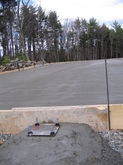Concrete?

Click here for concrete slab specifications. Our spec's will provide a durable, long lasting concrete slab, suited for any area of the country. It's not uncommon for local concrete contractors to say "this is overkill" and "I can skip the steel and save you money...", etc., but shortcuts aren't always worth the savings. If you skip the steel, when the concrete eventually cracks nothing will hold it together. If you use a lower psi mix, it might not hold up season after season or you couldn't drive over the pad. When you get an estimate, ask for both prices - a price to follow the spec's, and then with the specifications your contractor is recommending. View the difference in price as insurance, and decide if the savings is worth the risk. Click here for concrete spec's you can use.
Compacted Base Instructions
Using a compacted base has many benefits and is definitely worth exploring. For the customer who wants a large court (over 1200 sf) it's probably not a good choice, or if money's no object and you want the court forever. But for renters, homeowners with ordinance restrictions and permeable surface limits, or families with kids leaving home in a few years, a compacted base can be the right choice. The optimal size for a compacted base court is under 1200 square feet. Beyond that, the area becomes difficult to level. And a compacted base works better for basketball courts than for rectangular paddle/racquet courts, because a basketball is dribbled up & down while a small ball for racquet sports is hit horizontally. Any irregularity or inconsistency in the surface will result in a crazy ball reaction and take the fun out of the game. But for basketball, as long as there's no trip hazard and the area is fairly compact & firm, a compacted base works well.
In different parts of the country they use a favorite compact-able base material. In some areas it's crushed limestone, or granite dust, and many places used recycled concrete that's been crushed and pulverized into small rocks and dust. Basically, whatever the local cheap material is, that's used beneath brick pavers. Cost varies, but in Florida it's usually $30-$40 per cubic yard. To create a 3"- 4" layer will require a cubic yard for every 80 square feet of court. Click here for compact-able base instructions and check out the photo series below. Follow the outlined steps and if you do as nice a job as the homeowner did below, you'll have years of lasting enjoyment from your compacted base court.
In different parts of the country they use a favorite compact-able base material. In some areas it's crushed limestone, or granite dust, and many places used recycled concrete that's been crushed and pulverized into small rocks and dust. Basically, whatever the local cheap material is, that's used beneath brick pavers. Cost varies, but in Florida it's usually $30-$40 per cubic yard. To create a 3"- 4" layer will require a cubic yard for every 80 square feet of court. Click here for compact-able base instructions and check out the photo series below. Follow the outlined steps and if you do as nice a job as the homeowner did below, you'll have years of lasting enjoyment from your compacted base court.